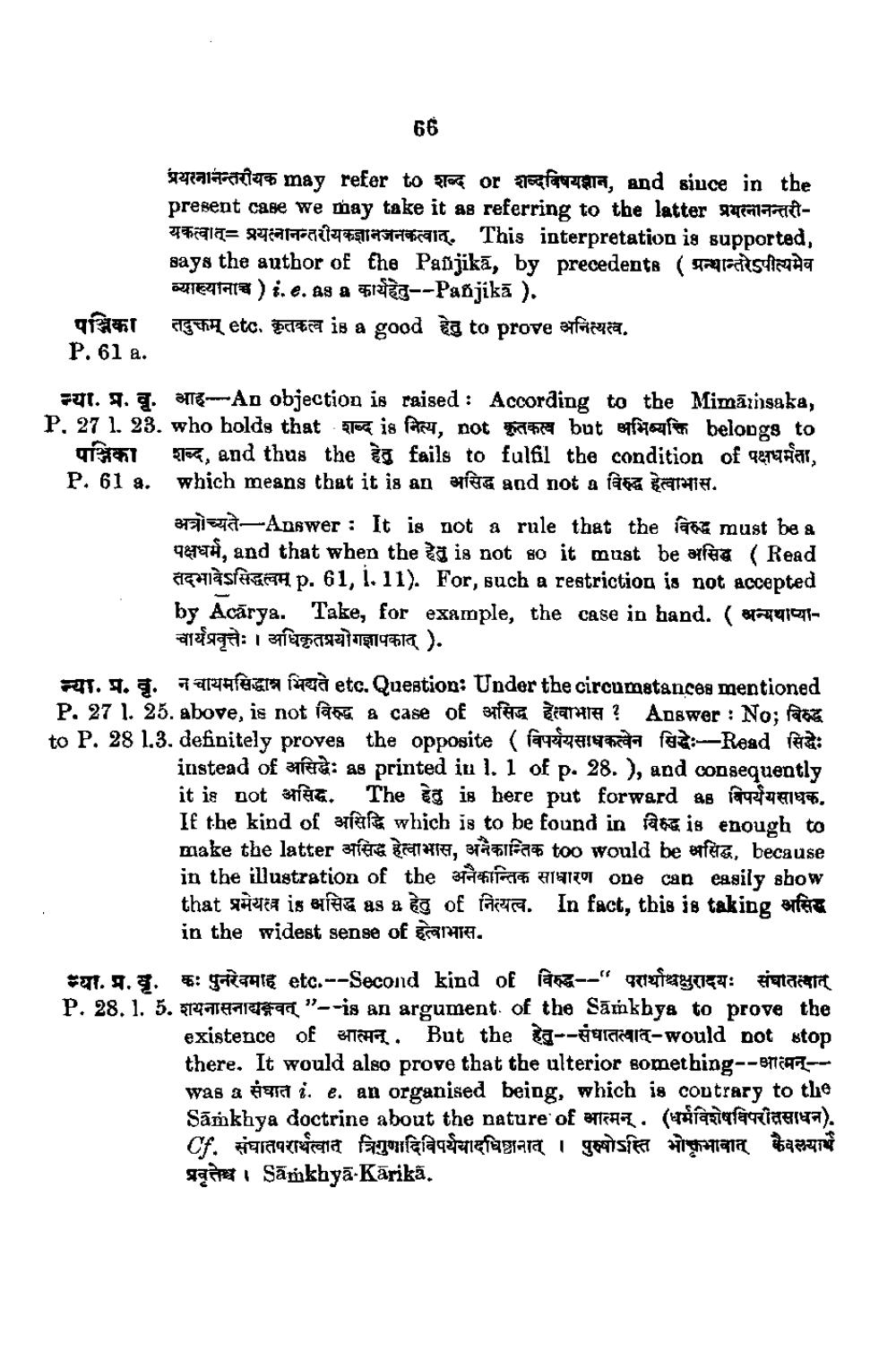________________
पञ्जिका
P. 61 a.
न्या. प्र. वृ. P. 27 1. 23.
पञ्जिका P. 61 a.
66
प्रयत्नानन्तरीयक may refer to शब्द or शब्दविषयज्ञान, and since in the present case we may take it as referring to the latter प्रयत्नानन्तरीयकत्वात् = प्रयत्नानन्तरीयकज्ञानजनकत्वात्. This interpretation is supported, says the author of the Pañjikā, by precedents ( अन्धान्तरेऽपीत्यमेव व्याख्यानाच्च ) i. e. as a कार्यहेतु-- Panjikā ).
तदुक्तम् etc. कृतकत्व is a good हेतु to prove अनित्यस्व.
आह---An objection is raised According to the Mimansaka, who holds that शब्द is नित्य, not कृतकत्व but अभिव्यक्ति belongs to शब्द, and thus the हेतु fails to fulfil the condition of पक्षधर्मता, which means that it is an असिद्ध and not a विरुद्ध हेत्वाभास.
अत्रोच्यते— Answer : It is not a rule that the विरुद्ध must be a पक्षधर्म, and that when the हेतु is not so it must be असिद्ध ( Read तदभावेऽसिद्धत्वम् p. 61, 1.11 ). For such a restriction is not accepted by Acārya. Take, for example, the case in hand. ( अन्यथाप्याचार्यप्रवृत्तेः । अधिकृतप्रयोगज्ञापकात् ).
न्या. प्र. वृ. न चायमसिद्धान्न भियते etc. Question: Under the circumstances mentioned P. 27 1. 25. above, is not विरुद्ध & case of असिद्ध हेत्वाभास ? Answer : No; विरुद्ध to P. 28 1.3. definitely proves the opposite ( विपर्ययसाधकत्वेन सिद्धेः -- Read सिद्धेः instead of असिद्धेः as printed in 1. 1 of p. 28. ), and consequently it is not असिद्ध. The हेतु is here put forward as विपर्ययसाधक. If the kind of असिद्धि which is to be found in विरुद्ध is enough to make the latter असिद्ध हेत्वाभास, अनैकान्तिक too would be असिद्ध, because in the illustration of the अनैकान्तिक साधारण one can easily show that प्रमेयत्व is असिद्ध as a हेतु of नित्यत्व. In fact, this is taking असिद्ध in the widest sense of हेत्वाभास.
न्या. प्र. वृ. कः पुनरेवमाह etc. --Second kind of विरुद्ध--" परार्थाश्चक्षुरादयः संघातत्वात् P. 28.1. 5. शयनासनाद्यद्भवत् "-- is an argument of the Samkhya to prove the
existence of आत्मन्. But the हेतु संघातत्वात्- would not stop there. It would also prove that the ulterior something--आत्मन्--- was a संघात ie an organised being, which is contrary to the Sāmkhya doctrine about the nature of आत्मन् (धर्मविशेषविपरीतसाधन). Cf. संघातपरार्थत्वात् त्रिगुणादिविपर्ययादधिष्ठानात् । पुरुषोऽस्ति भोकभावात् कैवल्यार्थ प्रवृत्ते | Samkhya-Karika.




